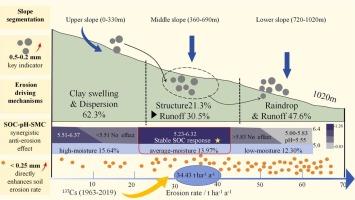Decoupling analysis of soil properties and slope-position interactions affecting erosion rates on long gentle slopes
IF 6.8
1区 农林科学
Q1 SOIL SCIENCE
引用次数: 0
Abstract
Soil erosion exhibits significant spatial heterogeneity and scale dependence. The relative uniformity of external conditions along the slope magnifies existing differences in soil properties, thereby reinforcing a dynamic feedback loop. Consequently, this study aimed to elucidate the mechanistic role of internal soil factors, with a particular focus on the hierarchical coupling between slope-scale response parameters and localized regulatory factors. A field investigation was conducted on a rolling hillslope in Northeast China. Cesium-137 (137Cs) radionuclide tracing was employed to quantify soil redistribution patterns, and soil parameters (aggregate stability, chemistry, fractal structure, and physical texture) were measured to explain spatial variations in erosion. The results showed that the synergistic effect of soil organic carbon (SOC) and pH played a key parameter influencing erosion processes, explaining up to 60 % of the variation in erosion rates. Soil moisture content served as an intrinsic regulatory factor, and at a moderate level (13.97 %), SOC exhibited a stable and significant resistance to erosion within a pH range of 5.23–6.32. The upper slope was primarily influenced by the coupled process of clay particles swelling and dispersion (contributing 62.3 %); the middle slope experienced cumulative effects of internal soil structure and runoff disturbance, leading to magnified erosion rates (21.3 % and 30.5 %, respectively); the lower slope was highly sensitive to the combined effects of raindrop impact and runoff disturbance, contributing 47.6 %. An increased proportion of the 0.2–0.1 mm aggregate fraction significantly intensified erosion, while the 0.5–0.2 mm fraction acted as an effective indicator of particle sorting and spatial redistribution. These findings provide a scientific basis for developing precision soil management strategies in agricultural landscapes.

长缓坡土壤性质与坡位相互作用影响侵蚀速率的解耦分析
土壤侵蚀表现出明显的空间异质性和尺度依赖性。沿坡的外部条件的相对均匀性放大了土壤性质的现有差异,从而加强了动态反馈回路。因此,本研究旨在阐明内部土壤因子的机制作用,特别关注坡尺度响应参数与局部调节因子之间的分层耦合。对东北某起伏山坡进行了野外调查。采用铯-137 (137Cs)示踪技术量化土壤再分配模式,并测量土壤参数(团聚体稳定性、化学、分形结构和物理质地)来解释侵蚀的空间变化。结果表明,土壤有机碳(SOC)和pH的协同效应是影响侵蚀过程的关键参数,可解释高达60% %的侵蚀速率变化。土壤含水量是土壤有机碳的内在调节因子,在中等水平(13.97 %)下,土壤有机碳在pH 5.23 ~ 6.32范围内表现出稳定且显著的抗侵蚀能力。上部边坡主要受粘土颗粒溶胀和分散耦合过程的影响(贡献率为62.3 %);中坡受内部土壤结构和径流扰动的累积效应,侵蚀速率增大(分别为21.3% %和30.5% %);下坡面对降雨冲击和径流扰动的综合影响高度敏感,贡献率为47.6 %。0.2 ~ 0.1 mm团聚体分数的增加显著加剧了侵蚀,而0.5 ~ 0.2 mm分数是颗粒分选和空间再分配的有效指标。这些发现为农业景观土壤精准管理策略的制定提供了科学依据。
本文章由计算机程序翻译,如有差异,请以英文原文为准。
求助全文
约1分钟内获得全文
求助全文
来源期刊

Soil & Tillage Research
农林科学-土壤科学
CiteScore
13.00
自引率
6.20%
发文量
266
审稿时长
5 months
期刊介绍:
Soil & Tillage Research examines the physical, chemical and biological changes in the soil caused by tillage and field traffic. Manuscripts will be considered on aspects of soil science, physics, technology, mechanization and applied engineering for a sustainable balance among productivity, environmental quality and profitability. The following are examples of suitable topics within the scope of the journal of Soil and Tillage Research:
The agricultural and biosystems engineering associated with tillage (including no-tillage, reduced-tillage and direct drilling), irrigation and drainage, crops and crop rotations, fertilization, rehabilitation of mine spoils and processes used to modify soils. Soil change effects on establishment and yield of crops, growth of plants and roots, structure and erosion of soil, cycling of carbon and nutrients, greenhouse gas emissions, leaching, runoff and other processes that affect environmental quality. Characterization or modeling of tillage and field traffic responses, soil, climate, or topographic effects, soil deformation processes, tillage tools, traction devices, energy requirements, economics, surface and subsurface water quality effects, tillage effects on weed, pest and disease control, and their interactions.
 求助内容:
求助内容: 应助结果提醒方式:
应助结果提醒方式:


